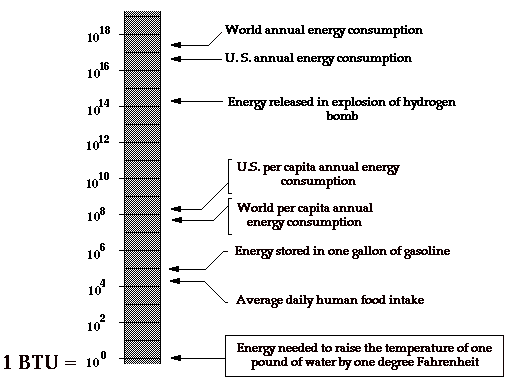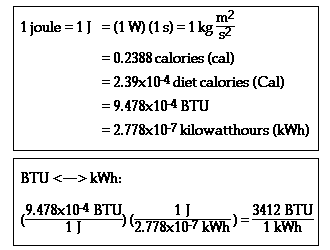
So here is a convenient BTU scale:

We shall often be interested just in 'ball-park' figures, that is, in orders of magnitude. For example, when comparing the amount of energy reaching Earth (from the Sun) with the amount of energy consumed in the world today, it will be sufficient to say that the former is approx. 4-5 orders of magnitude larger to conclude that we shall not run out of energy any time soon. Other times, we shall need to be more precise, well within an order of magnitude. For example, energy consumption per capita in the U.S. is approx. 5 times larger than in the world as a whole. Still other times, it will be important to distinguish between, say, a 32% and a 33% efficiency of an electric power plant; this is so because 1% increase in power plant efficiency translates into huge fuel and dollar savings (as we shall see).
Because different energy forms typically have different 'yardsticks', we need to become familiar with the interconversion of energy units. This is exactly analogous to the familiar conversion of monetary currencies. But because it can get slightly more involved, it is important to review here the procedure used in making such conversions.

Note that the value of every conversion factor is unity (or one); so it makes no difference which units are in the numerator and which ones are in the denominator. (The reciprocal of one is one.) This choice is dictated by the task at hand. If we are converting dollars into yen, the dollar in the conversion factor (currency exchange rate) must be in the denominator; if we are converting yen into dollars, the yen in the conversion factor must be in the denominator.
This procedure, together with the use of the concept of efficiency, is all the math that is needed in order to reach some rather important energy-related conclusions, regarding both residential comfort and energy policies.
Here is a short list of the most frequently used energy conversion factors, together with an example how to use it.

Here are some useful conversions:
1 kilocalorie is approximately equal to 4 BTU.
1 BTU is approximately equal to 1000 joules.
Energy: qualitative definition
Energy conversions
Energy conversion efficiency
Go back to MatSc 101 home page